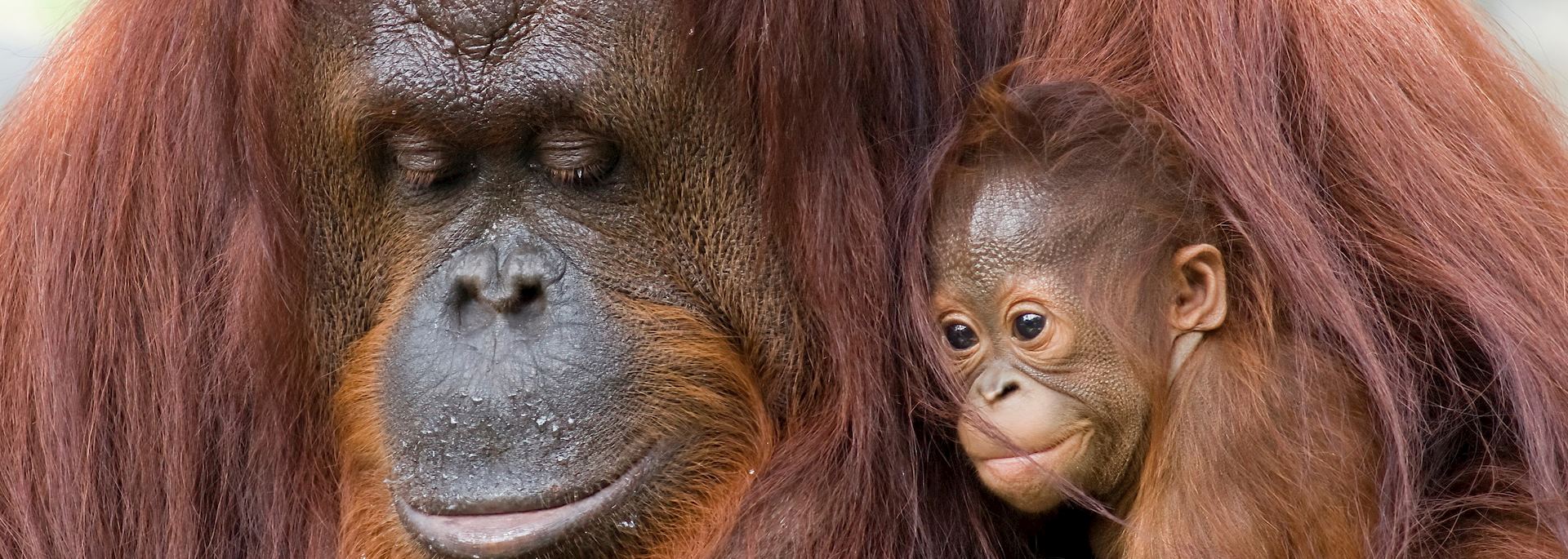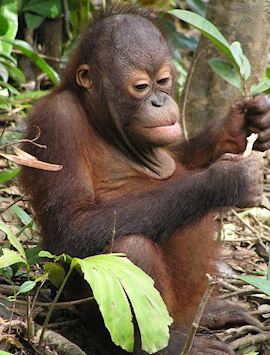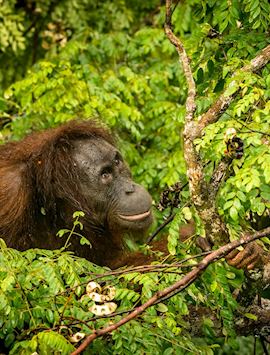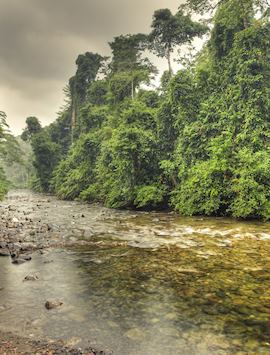By Borneo specialist Sophie
The first time you see an orangutan in the wild, it’s almost certainly because you’re in Borneo. The smells and sounds of the rainforest are around you — gibbons calling and cicadas singing. It’s quite the setting for seeing these animals play, swing and live among the treetops.
What’s maybe not quite so clear is where in Borneo? The island is part Malaysian, part Indonesian (with little Brunei wedged in the northern corner). And, combining the two into one orangutan-watching bonanza isn’t easy. Unless you have plenty of time, I suggest sticking to one country. Each side of the island has its own merits, and I don’t want to lean you one way or the other. Instead, I’m passing on my highlights for orangutan spotting on both sides of the border.

Borneo for orangutan spotting, in brief
Borneo has the Malaysian states of Sarawak and Sabah in the north, but the majority of the island is Kalimantan, part of Indonesia.
Sabah gives you the opportunity to visit a number of wildlife hotspots relatively close together. These include the Danum Valley, Kinabatangan River, Tabin Wildlife Reserve, Deramakot and the Sepilok Orangutan Rehabilitation Centre.
At Semenggoh in Sarawak you can see orangutans in a sanctuary, but rarely in the wild. It does offer a more rounded trip, though — you could visit an Iban tribe, for instance. With a network of domestic flights across Malaysian Borneo, it’s possible to combine both states in one trip focused on the orangutans of Borneo.
Finally, Tanjung Puting in Kalimantan is more adventurous feeling. The reserve fits into an island-hopping journey across Indonesia, particularly a trip combining Java and Kalimantan.
The only other island where you can see orangutans in the wild is Indonesian Sumatra, which lies to Borneo’s southwest. You could split your time here with Kalimantan on a grand tour of Indonesia.

Malaysian Borneo's orangutan highlights
Sepilok Orangutan Rehabilitation Centre, Sabah
Sepilok is based just outside Sandakan, your most likely entry point into Sabah by air. It provides a good introduction to the orangutans before you head to the jungle. Here you’re almost guaranteed to see rescued youngsters and adults at close quarters.
Your visit starts with a short video that explains the orangutans’ lifestyle and the survival challenges they face. There’s an exhibition worth lingering over, too, but the highlight comes from watching the orangutans swing in through the trees for their daily banana rations. You can stay at the nearby resort to catch the morning feeding.

Kinabatangan River, Sabah
An hour’s boat ride from Sandakan brings you to the Kinabatangan River and the heart of wild orangutan territory. Cruising on a small boat along the river and its tributaries lets you cover more ground and get closer to the animals (possibly including pygmy elephants) without imposing on their habitat, as you would do crunching through the jungle on foot. This is also one of the most leisurely ways to spot orangutans.
The best times for seeing wildlife are early morning and before sunset. From your boat in the mornings, you’ll catch sight of proboscis monkeys, macaques and orangutans waking up and starting their day’s foraging. And, arguably the best birdlife in Southeast Asia flits and darts along the river.
Before sunset, orangutans make their nest for the night high in the treetops. It’s not unusual to see mothers with babies clasped to their bellies.
Night-time boat trips expose you to nocturnal wildlife, aided by a skilled guide and a powerful torch. It’s common to spot crocodiles’ eyes glinting from the water, as well as kingfishers perched along the banks and (no exaggeration) thousands of fireflies. I’ve also seen flying squirrels and owls.
I suggest staying at one of the lodges on the Menanggul Tributary in a simple wooden chalet.

Danum Valley, Sabah
One of the last patches of primary rainforest in Borneo, the Danum Valley shelters a sizeable population of orangutans within close reach of the luxurious Borneo Rainforest Lodge.
From the Kinabatangan River, it’s a five-hour drive to the lodge, which sits on a bend of the Danum River, giving you a ringside seat to watch any orangutans that venture down from the canopy for a drink.
The rooms here are as luxurious as you’d hope to find in the heart of any rainforest. I was also impressed by the knowledge of the resident guides. Your private guide will take you along trails in search of the orangutans, which number a healthy 500, helping you locate them in among the dense foliage. They’ll also point out the forest plants, whose uses extend from medicines to basket weaving.
Danum’s canopy walkway elevates you to life in the treetops, where you might spot bird species like Wallace’s hawk-eagle and the Bornean bristlehead. You can also join a safari vehicle to take you farther into the forest for possible sightings of pygmy elephants, several deer species, bearded pigs, and even clouded leopards and Malayan sun bears.

Tabin Wildlife Reserve
Tabin serves as an alternative to the Danum Valley where you have a great chance to see orangutans released from Sepilok. The lodge here is less impressive and sits on the edge of the reserve, but you’re in the best place for seeing leopard cats. There’s also a higher chance of seeing pygmy elephants, confined to a smaller territory than elsewhere.
Here, like Danum, the guides keep in touch by walkie-talkie, passing along any interesting wildlife sightings they encounter. I found it particularly exhilarating to track wildlife this way, anticipating an orangutan or elephant around the next corner.
Tabin also has several mineral-rich mud volcanoes and salt-water springs that attract a variety of nutrient-seeking hornbills, civets, orangutans and leopard cats. And, it’s worth noting that, unlike Danum, this is secondary rainforest and close to logging areas and palm oil plantations (although the ecology is more diverse as a consequence).
.jpg?q=79&w=800&h=266)
Deramakot Forest Reserve, Sabah
If you’re itching to escape the usual orangutan-seeker’s trail, look to Deramakot Forest Reserve. One of the first FSC-certified forestry reserves, this mixed dipterocarp rainforest has become a blueprint for how to run a sustainable commercial project to halt deforestation across Borneo.
Careful stewardship of the forest has encouraged a long list of wildlife, and it’s the only place you can potentially spot all five of Borneo’s cat species. There’s a healthy population of orangutans, as well as gibbons, sambars, macaques and pygmy elephants. Wildlife sightings can come thick and fast (though we can never guarantee them), unlike sightings of fellow visitors during your stay in this remote enclave.
It’s a four-hour drive from Sandakan, the nearest settlement, to the park headquarters. There’s no hotel, instead you stay in a simple (though air-conditioned and en suite) chalet that’s maintained by the forestry team. To explore, you and your wildlife guide drive deep into the forest in a 4x4, armed with a spotlight if you’re heading out after dark.

Semenggoh Wildlife Rehabilitation Centre, Sarawak
Laid-back Semenggoh offers an intimate wildlife-viewing experience — it’s also less well-known and quieter than Sepilok. That said, spotting any orangutans isn’t guaranteed, particularly when the trees are in fruit, preoccupying the orangutans with nature’s bounty.
The sanctuary’s location outside Sarawak’s capital, Kuching, makes it easy to combine visiting the two. You can also stop off on the way to staying with an Iban tribe, and cruises along the Santubong River could result in seeing Irrawaddy dolphins, proboscis monkeys and saltwater crocodiles.

Indonesian Borneo's orangutan highlights
Tanjung Puting National Park, Kalimantan
There's no other way to say it — getting to see orangutans in Indonesia is a challenge. Flights, boats and 4x4s are par for the course but, despite the challenges in reaching your end destination, the rewards far outweigh the effort. Orangutan sightings are all but guaranteed, and the park’s excellent rehabilitation reserve is much less frequented than those in Borneo.
In Tanjung Puting National Park, the (approximately) 5,000 orangutans are completely free to roam, supplementing their diet at feeding stations where you can watch.
Camp Leakey Orangutan Rehabilitation Centre gives you the opportunity to see at close hand the orphaned and rescued orangutans in its care.
Journeying along the Sekonyer River is your way of getting close to orangutans and other wildlife drawn to the riverbanks. The feeding stations are in clearings nearby the water, and your klotok (private boat) will stop at a pontoon so you can make the short walk to wait for the show to start. A ranger calls out to announce feeding time and the trees soon shake as wild orangutans swing past you.

I was surprised by how little attention they paid to humans. I watched for about an hour, during which Tom, a large male, took the lion’s share of the bananas, clearly intimidating the other orangutans. One cheeky gibbon did sneak onto the platform to pinch a few bananas but scarpered before Tom could react.
I suggest spending two or three days on your boat to boost the number of orangutan encounters you have. It can be basic on board, but you can choose an air-conditioned cabin above sleeping on deck under mosquito nets. Although, I loved the experience of sleeping out under the stars, listening to cicadas and waking to the splash of crocodiles in the water below. On one trip, a pod of Irrawaddy dolphins swam alongside our klotok.
You reach Tanjung Puting from the town of Kumai in southwest Kalimantan, where your flight will land and your guide and driver will meet you and take you to the jetty to board your klotok.

Supporting orangutan conservation
The threat to orangutans comes from many angles: illegal hunting and trading, habitat destruction for farmland and palm oil plantations, and encroaching humans.
Sepilok Orangutan Rehabilitation Centre is supported by Orangutan Appeal UK. This British-based charity also champions projects and initiatives across the country, and internationally. You can choose to ‘adopt’ an orangutan before you visit the centre, with a chance to see it when you arrive. The price of your adoption is ploughed back into Sepilok’s upkeep.
Start planning your wildlife spotting trip to Malaysian or Indonesian Borneo
Start thinking about your experience. These itineraries are simply suggestions for how you could enjoy some of the same experiences as our specialists. They're just for inspiration, because your trip will be created around your particular tastes.
View All Tours in Borneo




